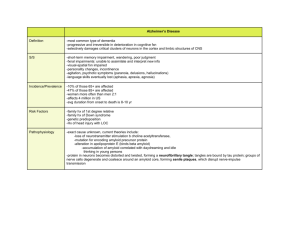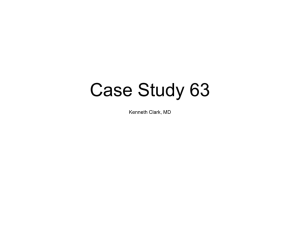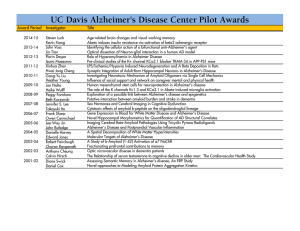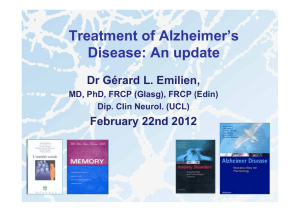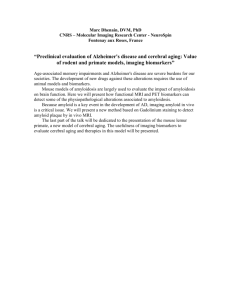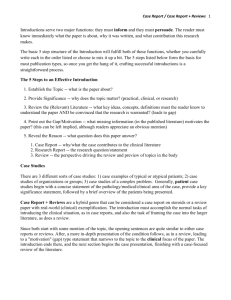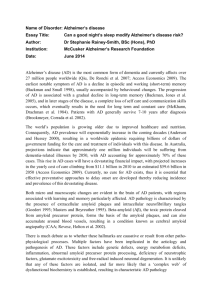Spontaneous ARIA (amyloid-related imaging abnormalities) and cerebral
advertisement
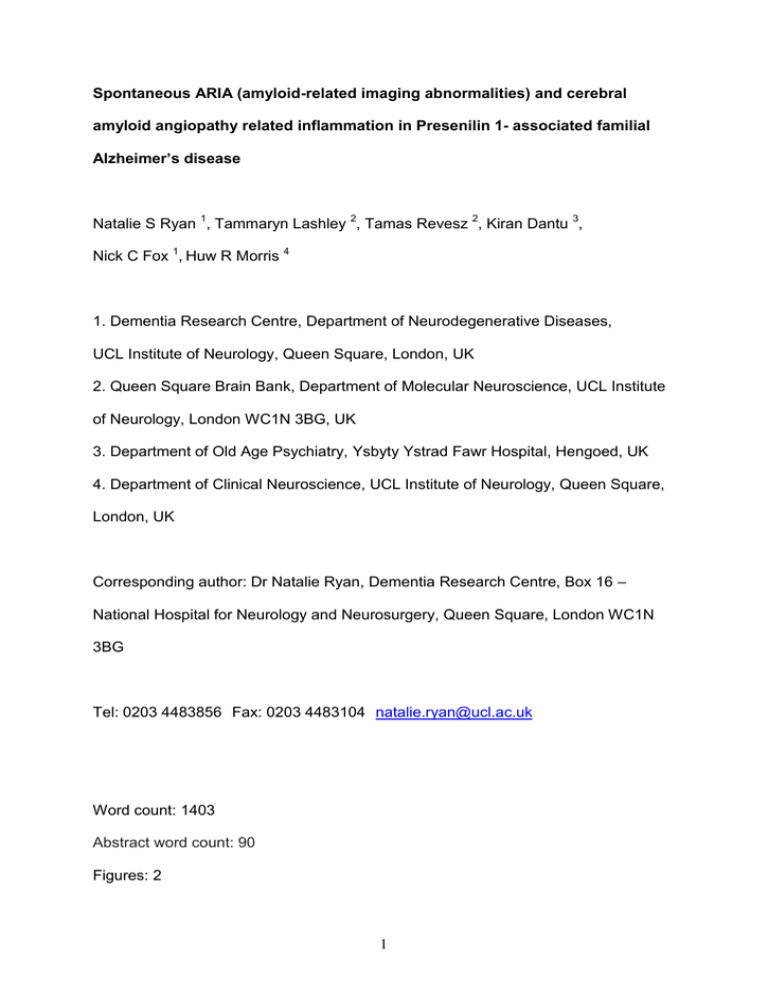
Spontaneous ARIA (amyloid-related imaging abnormalities) and cerebral amyloid angiopathy related inflammation in Presenilin 1- associated familial Alzheimer’s disease Natalie S Ryan 1, Tammaryn Lashley 2, Tamas Revesz 2, Kiran Dantu 3, Nick C Fox 1, Huw R Morris 4 1. Dementia Research Centre, Department of Neurodegenerative Diseases, UCL Institute of Neurology, Queen Square, London, UK 2. Queen Square Brain Bank, Department of Molecular Neuroscience, UCL Institute of Neurology, London WC1N 3BG, UK 3. Department of Old Age Psychiatry, Ysbyty Ystrad Fawr Hospital, Hengoed, UK 4. Department of Clinical Neuroscience, UCL Institute of Neurology, Queen Square, London, UK Corresponding author: Dr Natalie Ryan, Dementia Research Centre, Box 16 – National Hospital for Neurology and Neurosurgery, Queen Square, London WC1N 3BG Tel: 0203 4483856 Fax: 0203 4483104 natalie.ryan@ucl.ac.uk Word count: 1403 Abstract word count: 90 Figures: 2 1 ABSTRACT Amyloid-related imaging abnormalities (ARIA), thought to reflect immune responses to vascular amyloid, have been detected in several amyloid-modifying therapy trials for Alzheimer’s disease (AD). We report a case of ARIA developing spontaneously during the course of Presenilin 1 (PSEN1)-associated familial AD (FAD), in an APOE4 homozygous patient. Severe cerebral amyloid angiopathy (CAA) with associated inflammation was subsequently found at autopsy. Recognition that ARIA may arise spontaneously during FAD and of the potential risk factors for its development are important observations given the recent launch of amyloidmodifying therapy trials for FAD. Keywords: familial Alzheimer’s disease; MRI; Presenilin 1, APOE, cerebral amyloid angiopathy-related inflammation 2 INTRODUCTION The term ‘ARIA’ has been proposed to describe the amyloid-related MRI abnormalities observed in a number of patients participating in various amyloidmodifying therapy trials for AD [1-5]. ARIA refers to a spectrum of imaging changes and may be subdivided into ARIA-E, describing increased signal on fluid-attenuated inversion recovery (FLAIR) and other T2-weighted MRI sequences, thought to represent cerebral oedema and effusion or extravasated fluid in sulcal spaces, and ARIA-H, denoting microhaemorrhages and superficial siderosis evident on gradient echo (T2*-GRE) sequences. ARIA are thought to reflect changes involving vascular amyloid, although a detailed understanding of their pathogenesis remains to be elucidated. Recognition that the clinical and neuroimaging features of ARIA are similar, although in general milder, to those of the spontaneously occurring condition CAA-related inflammation (CAA-ri) supports the hypothesis that an immunological response to vascular amyloid, with increased vascular permeability, may be a common underlying pathophysiological mechanism [6]. Some degree of CAA is found at post-mortem in up to 90% of AD patients [7] and the observation of changes resembling ARIA-E in a small number of cases undergoing screening for clinical trials suggests that it may rarely occur during the natural history of AD [8]. Its prevalence, however, is unknown and to our knowledge this is the first reported case of ARIA-E developing spontaneously during the course of PSEN1-associated FAD. CASE REPORT The patient developed gradual impairment of episodic memory from age 48. She was an ex-smoker with a history of treated hypercholesterolaemia and depression. On initial assessment, aged 53, she had finger myoclonus bilaterally and scored 3 25/30 on the MMSE. Neuropsychological assessment revealed significant impairment of immediate and delayed recall memory with language function at the lower limit of normal. Visuospatial and executive functions were relatively intact. A lumbar puncture (LP) demonstrated acellular CSF with a protein level of 0.4g/L. As a similar illness had affected her father from the age of 67 and two of her sisters from their early 50s, genetic testing was carried out. This identified the novel PSEN1 I202F mutation in the patient and her affected siblings [9]. Her APOE genotype was e4 homozygous. She was treated with a cholinesterase inhibitor and the first nine years of her illness followed a gradually progressive course. At the age of 57, she underwent a sub-acute deterioration in cognition and behaviour over a period of several weeks, becoming more emotionally labile and losing the ability to dress herself or hold a conversation. There were no associated headaches, seizures or signs of systemic infection. An MRI scan at this stage demonstrated florid white matter hyperintensities, particularly in a parieto-occipital distribution where they extended to involve the U-fibres and were associated with marked focal loss of sulcal spaces suggestive of oedema (Figure 1). The imaging abnormalities were bilateral but more prominent in the left hemisphere. T2*-GRE sequences were not acquired. The prospect of a further LP and steroid treatment was discussed with her family but a conservative approach was chosen. Her agitation improved on Quetiapine and the course of her cognitive impairment appeared to return to the gradual rate of decline which it had previously followed. A follow up MRI nine months later showed that there had been some spontaneous improvement in the severity of white matter change and oedema. Unfortunately, she was unable to tolerate scanning long enough to acquire T2-FLAIR and T2*-GRE sequences on this occasion. Two months after the final scan she developed visual hallucinations and misperceptions, motor 4 stereotypies and worsened agitation. An empirical trial of Prednisolone was given for a month; the family felt that this was associated with some functional improvement initially but it was not sustained and she couldn’t tolerate increased doses. She continued to deteriorate, developed seizures and was admitted to a Nursing Home. She died 10 months after her final scan and 11 years after the onset of her illness. Her brain was donated to the Queen Square Brain Bank for Neurological Disorders where tissue is stored under a licence from the Human Tissue Authority. Brain weight was 1038g and macroscopic investigation confirmed severe cerebral atrophy, reduction in bulk of the hemispheric white matter, marked reduction in size of the hippocampus and amygdala and pallor of the locus coeruleus. Microscopic investigation of histological slides from representative regions of the right hemisphere of the brain demonstrated end-stage AD pathology with severe neurofibrillary tangle pathology (Braak and Braak stage VI) and extensive mature and diffuse Aβ-positive parenchymal plaques (Thal phase 5). Tau immunohistochemistry confirmed the presence of ‘frequent’ neuritic plaques in all CERAD (Consortium to Establish a Registry for AD) cortical regions. Aβ immunohistochemistry also revealed ‘severe’ CAA with focal collections of mononuclear inflammatory cells, mostly CD3-positive T lymphocytes and CD68positive macrophages, around some of the leptomeningeal and cortical blood vessels. One leptomeningeal small arteriole showed invasion of its thickened walls by CD3-positive T-cells (Figure 2), but no multinucleated giant cells were identified. Using special stain (MSB method) no fibrinoid necrosis of the walls of this or other leptomeningeal or cortical blood vessels could be demonstrated. A sparse diffuse chronic inflammatory cell infiltrate was present in the leptomeninges. In addition, 5 there was marked diffuse increase of CD68-positive microglia/macrophages in the parenchyma of both cerebral cortex and subcortical white matter, which was slightly more severe in the temporal, parietal and occipital areas than in the frontal region. No haemorrhagic changes were seen. Some of the macrophages were observed to contain pigment, however this was negative for haemosiderin on Perls stain. As the MRI changes were more prominent in the left hemisphere, frozen tissue from the left parietal and occipital cortices was also examined. This demonstrated a small, cavitating infarct in the left occipital cortex and subcortical white matter invaded by macrophages and T lymphocytes. Macrophages and microglia were focally numerous in the surrounding brain parenchyma surrounding the infarct. -Synuclein immunohistochemistry demonstrated amygdala predominant Lewy pathology. DISCUSSION The appearance of ARIA-E in this patient coincided with a period of clinical deterioration. As there was an interval of almost two years between this episode and the post-mortem examination, the exact cause of the imaging abnormalities can only be hypothesised. However, the pathological findings do support the idea that an immune/inflammatory response to vascular amyloid was implicated. There was severe CAA, with a chronic inflammatory infiltrate surrounding some of the cortical and leptomeningeal blood vessels. One leptomeningeal arteriole also showed transmural inflammation indicative of vasculitis. This case therefore adds further support to a growing body of literature linking CAA-ri to radiological features described as ARIA [10]. Whilst the precise underlying pathogenetic mechanisms are not yet fully understood, previous observations of CD68+ macrophages and CD4+ Tcell recruitment at sites of Aβ-related angiitis [11, 12] and CSF anti-Aβ 6 autoantibodies in patients with spontaneous CAA-ri [6, 13] support the notion of an autoimmune response against vascular Aβ [10]. Several factors may have predisposed the patient to developing this complication. PSEN1 mutations located beyond codon 200 have been reported to be associated with particularly severe CAA [14], and her APOE-e4 homozygosity may have increased her risk of developing CAA-ri. In clinical trials of the humanized anti-Aβ antibody bapineuzumab, the frequency of ARIA-E increased with APOE-e4 gene dose [4, 5]. Spontaneous CAA-ri is also associated with APOE-e4 homozygosity [15, 16]. Capillary CAA, observed in the occipital cortex of this patient, may play an important role here as it has been found to both associate with the APOE-e4 allele [17] and to provoke a particularly strong inflammatory response, unlike larger vessel CAA [18]. This individual’s vascular risk factors may have rendered her further vulnerable to developing blood-brain barrier dysfunction and increased vascular permeability. Investigation of the degree of CAA and inflammation in APOE-e4 noncarriers with this PSEN1 mutation would be an interesting avenue for future research. The development of ARIA-E should be further evaluated as a possible cause of subacute deterioration in patients with established AD. Recognition that it may arise spontaneously during the course of FAD is particularly timely with amyloid-modifying therapy trials for FAD underway. Although many of the participants in these trials will be presymptomatic, certain genetic factors may increase the risk of developing ARIA, even prior to the onset of clinical disease. This has been illustrated by a case report of ARIA developing spontaneously in a cognitively normal APP duplication 7 carrier [19]. Monitoring for ARIA, investigating the underlying pathophysiological mechanisms and identifying individuals at increased risk of developing them will be a crucial part of both natural history studies and treatment trials in AD. Acknowledgements We thank the patient’s family for allowing us to publish her case and the MRC Prion Unit at UCL Institute of Neurology for conducting the APOE genotyping. NSR holds a Brain Exit Fellowship and has been supported by an MRC Clinical Research Training Fellowship. TL is supported by an Alzheimer’s Research UK fellowship, NCF holds an NIHR Senior Investigator award. The Dementia Research Centre is an Alzheimer’s Research UK Co-ordinating Centre. We are grateful for support from the NIHR Queen Square Dementia BRU and the Leonard Wolfson Experimental Neurology Centre. Reference List [1] Sperling RA, Jack CR, Jr., Black SE, Frosch MP, Greenberg SM, Hyman BT, Scheltens P, Carrillo MC, Thies W, Bednar MM, Black RS, Brashear HR, Grundman M, Siemers ER, Feldman HH, Schindler RJ (2011) Amyloid-related imaging abnormalities in amyloid-modifying therapeutic trials: Recommendations from the Alzheimer's Association Research Roundtable Workgroup. Alzheimers.Dement 7, 367-385. [2] Coric V, van Dyck CH, Salloway S, Andreasen N, Brody M, Richter RW, Soininen H, Thein S, Shiovitz T, Pilcher G, Colby S, Rollin L, Dockens R, Pachai C, Portelius E, Andreasson U, Blennow K, Soares H, Albright C, Feldman HH, Berman RM (2012) Safety and tolerability of the gamma-secretase inhibitor avagacestat in a phase 2 study of mild to moderate Alzheimer disease. Arch Neurol 69, 1430-1440. 8 [3] Ostrowitzki S, Deptula D, Thurfjell L, Barkhof F, Bohrmann B, Brooks DJ, Klunk WE, Ashford E, Yoo K, Xu ZX, Loetscher H, Santarelli L (2012) Mechanism of amyloid removal in patients with Alzheimer disease treated with gantenerumab. Arch Neurol 69, 198-207. [4] Sperling R, Salloway S, Brooks DJ, Tampieri D, Barakos J, Fox NC, Raskind M, Sabbagh M, Honig LS, Porsteinsson AP, Lieberburg I, Arrighi HM, Morris KA, Lu Y, Liu E, Gregg KM, Brashear HR, Kinney GG, Black R, Grundman M (2012) Amyloid-related imaging abnormalities in patients with Alzheimer's disease treated with bapineuzumab: a retrospective analysis. Lancet Neurol 11, 241-249. [5] Salloway S, Sperling R, Fox NC, Blennow K, Klunk W, Raskind M, Sabbagh M, Honig LS, Porsteinsson AP, Ferris S, Reichert M, Ketter N, Nejadnik B, Guenzler V, Miloslavsky M, Wang D, Lu Y, Lull J, Tudor IC, Liu E, Grundman M, Yuen E, Black R, Brashear HR, Bapineuzumab, Clinical Trial I (2014) Two phase 3 trials of bapineuzumab in mild-to-moderate Alzheimer's disease. N Engl J Med 370, 322-333. [6] Piazza F, Greenberg SM, Savoiardo M, Gardinetti M, Chiapparini L, Raicher I, Nitrini R, Sakaguchi H, Brioschi M, Billo G, Colombo A, Lanzani F, Piscosquito G, Carriero MR, Giaccone G, Tagliavini F, Ferrarese C, DiFrancesco JC (2013) Antiamyloid beta autoantibodies in cerebral amyloid angiopathy-related inflammation: implications for amyloid-modifying therapies. Ann Neurol 73, 449-458. [7] Bergeron C, Ranalli PJ, Miceli PN (1987) Amyloid angiopathy in Alzheimer's disease. Can.J Neurol Sci. 14, 564-569. [8] Carlson C, Estergard W, Oh J, Suhy J, Jack CR, Jr., Siemers E, Barakos J (2011) Prevalence of asymptomatic vasogenic edema in pretreatment Alzheimer's disease study cohorts from phase 3 trials of semagacestat and solanezumab. Alzheimers Dement 7, 396-401. [9] Church A, Prescott J, Lillis S, Rees J, Chance P, Williamson K, Morris HR (2011) A novel presenilin 1 mutation, I202F occurring at a previously predicted pathogenic site causing autosomal dominant Alzheimer's disease. Neurobiol Aging 32, 556-552. 9 [10] Greenberg SM, Frosch MP (2011) Life imitates art: anti-amyloid antibodies and inflammatory cerebral amyloid angiopathy. Neurology 76, 772-773. [11] Bogner S, Bernreuther C, Matschke J, Barrera-Ocampo A, Sepulveda-Falla D, Leypoldt F, Magnus T, Haag F, Bergmann M, Bruck W, Vogelgesang S, Glatzel M (2014) Immune activation in amyloid-beta-related angiitis correlates with decreased parenchymal amyloid-beta plaque load. Neurodegener Dis 13, 38-44. [12] Melzer N, Harder A, Gross CC, Wolfer J, Stummer W, Niederstadt T, Meuth SG, Marziniak M, Grauer OM, Wiendl H (2012) CD4(+) T cells predominate in cerebrospinal fluid and leptomeningeal and parenchymal infiltrates in cerebral amyloid beta-related angiitis. Arch Neurol 69, 773-777. [13] DiFrancesco JC, Brioschi M, Brighina L, Ruffmann C, Saracchi E, Costantino G, Galimberti G, Conti E, Curto NA, Marzorati L, Remida P, Tagliavini F, Savoiardo M, Ferrarese C (2011) Anti-Abeta autoantibodies in the CSF of a patient with CAArelated inflammation: a case report. Neurology 76, 842-844. [14] Mann DM, Pickering-Brown SM, Takeuchi A, Iwatsubo T (2001) Amyloid angiopathy and variability in amyloid beta deposition is determined by mutation position in presenilin-1-linked Alzheimer's disease. Am J Pathol. 158, 2165-2175. [15] Eng JA, Frosch MP, Choi K, Rebeck GW, Greenberg SM (2004) Clinical manifestations of cerebral amyloid angiopathy-related inflammation. Ann Neurol 55, 250-256. [16] Kinnecom C, Lev MH, Wendell L, Smith EE, Rosand J, Frosch MP, Greenberg SM (2007) Course of cerebral amyloid angiopathy-related inflammation. Neurology 68, 1411-1416. [17] Thal DR, Ghebremedhin E, Rub U, Yamaguchi H, Del Tredici K, Braak H (2002) Two types of sporadic cerebral amyloid angiopathy. J Neuropathol Exp.Neurol 61, 282-293. [18] Richard E, Carrano A, Hoozemans JJ, van Horssen J, van Haastert ES, Eurelings LS, de Vries HE, Thal DR, Eikelenboom P, van Gool WA, Rozemuller AJ 10 (2010) Characteristics of dyshoric capillary cerebral amyloid angiopathy. J Neuropathol Exp.Neurol 69, 1158-1167. [19] Chamard L, Wallon D, Pijoff A, Berger E, Viennet G, Hannequin D, Magnin E (2013) Amyloid-related imaging abnormalities in AbetaPP duplication carriers. J Alzheimers Dis 37, 789-793. 11 Figure 1. Serial MRI scans demonstrating the appearance and then subsequent partial resolution of ARIA 12 Figure 2. Pathological analysis. Macroscopic observation of coronal slices confirmed cerebral atrophy and dilatation of the lateral ventricle with a reduction in bulk of the deep white matter and size of the hippocampus (A; arrow). Aβ immunohistochemistry showed numerous plaques (B) both cored (C) and diffuse. Severe CAA was found in the parenchyma (B, arrow) and leptomeninges (D) and was also found to affect capillaries in the occipital cortex (E). Numerous neurofibrillary tangles and neuropil threads were highlighted with tau immunohistochemistry (F) in the CA1 hippocampal subregion. Severe gliosis was observed throughout all cortical regions with GFAP immunohistochemistry (G) together with increased numbers of reactive microglia (H). Additional Lewy body and Lewy neurite pathology was seen in the amygdala (I). Some leptomeningeal blood vessels were surrounded by focal collections of mononuclear inflammatory cells, mostly CD3-positive T lymphocytes and CD68-positive macrophages (K), with one leptomeningeal small arteriole showing invasion of its thickened walls by CD3positive T-cells (L). B-I and K and L are immunohistochemical preparations, B-E: A ; F: Tau (AT8 antibody); G: GFAP; H and K: CD68; I: -Synuclein; L: CD3; J: Haematoxylin and eosin. Bar in B represents 100μm in B, D; 50 μm in H, J, K and L; 20μm in C,E, F and I. 13 14


